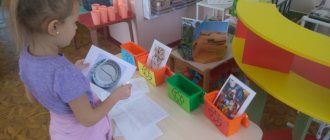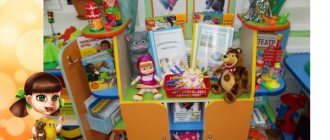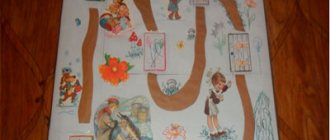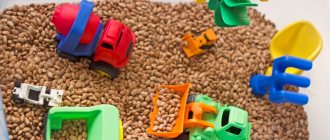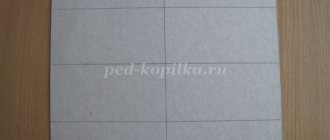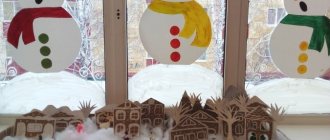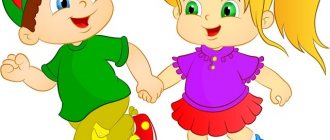Passport for the multifunctional teaching aid “Vsyusha the Doll”
KSPO "Nursery No. 40", p. Denisovka, st. Sovetskaya, 32 a
Phone/fax 8 (714-34) 2-14-37
______________________________________________________________________________
Passport of a multifunctional teaching aid
“Everything Doll”
Author: Mityukhina Tatyana Viktorovna methodologist of the Municipal State Public Enterprise “Nursery No. 40”
Denisovka village
November 2017
Here's the doll. And everything about it is simple:
Figure, eyes and hairstyle She is short,
it's a small "fabric". And although there is no living heart in her bosom, perhaps, But life also lives next to her lover. I love her and suffer, Playing all her games, Collecting moments of a happy life drop by drop.
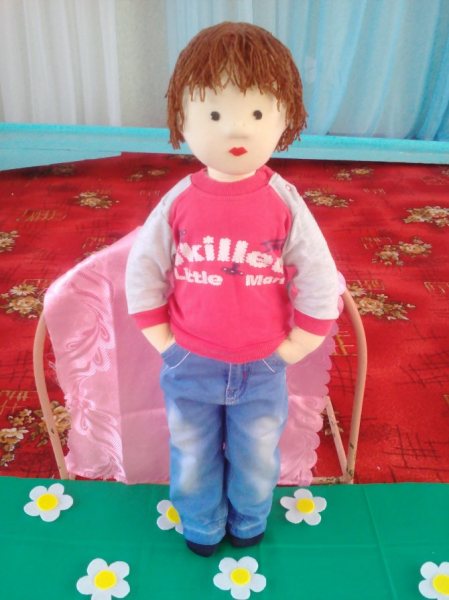
Purpose of this guide:
Development of students' independence and initiative, interests and cognitive abilities, intellectual development based on practical actions, development of students' creative potential in the game.
Tasks:
develop curiosity and cognitive motivation
• develop imagination and creativity
• form primary ideas: about yourself, other people, your small homeland, about objects in the surrounding world, about the properties and relationships of objects in the surrounding world (shape, color, size, material, quantity, part and all, space, movement and rest, reasons and consequences, etc.)
• enrich and activate vocabulary
• develop all types of perception: visual, auditory, tactile-motor.
Methodological value:
A multifunctional manual aimed at solving several problems at once, it is intended for working with children of different ages and allows taking into account the individual characteristics of the child’s development.
The variation of the exercise has no limits. The guide can be constantly updated with new elements.
Application area
The mat can be used in joint activities between a teacher and children, in independent children’s activities (manipulating various objects) and in individual work with a child. Finds application in all areas of education
Children's age
: from 2 to 6 years
The teaching aid is a large papier-mâché doll covered with padding polyester and soft flannel fabric. The doll's hands are soft and easy to fold.
The head is lined with flannel fabric, allowing you to quickly and easily change looks with interchangeable felt pieces.
The doll's name is Vsyusha. He says the doll can be used anywhere, in any activity with children: educational, educational, outside of school.
The benefit is intended for children from 2 to 6 years old.
What else to read: Using pedagogical technology “Travel on a map in working with children of senior preschool age”
The manual is multifunctional. This toy is a transformer.
Vsyusha is not just an educational doll, she is an excellent friend and assistant for our children and teachers.
Vseyusha is an active working method in educational activities (as play motivation). Such an assistant can be used as a special method of working in the classroom.
She easily, imperceptibly for children, switches from one character to another, which makes her mysterious, “alive.” Just turn around, change the wig, eyes, lips and eyebrows and now preschoolers have a completely different hero!
The doll's head has Velcro fasteners for attaching removable wigs made of colored yarn and synthetic hair.
Removable parts - eyes, lips, eyebrows, beard, mustache - are made of soft felt. This allows you to change the image of the doll in seconds; such a toy is simply irreplaceable in a group, because it is very convenient and compact.
By communicating with the doll, children gain sensory experience, become familiar with basic colors, professions, fairy tale characters, seasonal changes in nature, and emotions.
With the help of Vsyusha, it is easy and fun to learn to count, read, and explore the world of emotions and theater.
Vsyusha’s chest contains a lot of clothes and accessories, which are in separate boxes:
- wigs
- removable parts (eyes, lips, beard, eyebrows)
- costumes “Seasons” (autumn, winter, spring, summer)
- costumes “Fairy-Tale Heroes” (Kuzya the Brownie, Baba Yaga, Thumbelina, Malvina, Snow Maiden, Mashenka, Grandfather, Woman, Little Red Riding Hood, Foxes, Teddy Bear, Rabbit, Cat, Dog, Boh)
- national costumes (Russian, Kazakh, Tajik, Azerbaijani, Ukrainian (women's, men's), Lithuanian, German, Georgian, Belarusian, Uzbek)
- full “Watercolor”
- headwear (scarves, hats, caps, headbands, crowns, garlands)
- training aprons (with two transparent pockets, three transparent pockets and regular pockets in different colors)
- professions (doctor, cook, teacher, fireman, traffic inspector, hairdresser)
- seasonal clothing
- accessories (bags, belts, beads)
Here, in the chest, is a series of didactic materials (cards: “Studying colors”, “Mixing colors”, “Gzhel”. “Khokhloma”, “Gorodets painting”, “Decorative elements of painting”, “Pets”, “Wild animals” , “Vegetables”, “Fruits”, “Dangerous objects”, household appliances”, “Numbers”, “Russian, Kazakh, English language letters”, “Study of emotions”, “Products”, “Kazakh ornament”, “Edible and inedible mushrooms”, “Geometric shapes”.
- decorative elements with Velcro: flowers, colorful leaves, cups, snowflakes, droplets
The Vsyusha doll comes complete with flannel, decorative fastenings - four seasons with Velcro.
Vseyusha is a wonderful guide that has developmental, educational and educational significance. It can be used in almost all types of educational activities, games, work, art and independent activities.
Manipulations with various materials: buttons, drawstring, braid contribute to the development of fine motor skills of the hands.
Vseyusha is the main character of the study of life safety in the senior group.
In such classes, Vsyusha turns into housewife Kuzya, with the help of whom children learn the rules of safe behavior. Due to the fact that all parts of the doll's head are removable, it is very easy and interesting to explore the world of emotions.
What else to read: DIY tulips made from plastic spoons. Master class with step-by-step photos
During science lessons, Vsyusha turns into a small drop “Kapitoshka”, with which children enjoy exploring the world of living and inanimate nature.
In lessons to familiarize themselves with the environment, Vsyusha introduces children to the world of professions, and in fiction lessons, Vsyusha is the hero of her favorite fairy tales.
In a mathematics lesson, Vsyusha, in the guise of a “learned professor,” teaches children to count and solve simple problems.
During drawing lessons, Vsyusha turns into a “Watercolor” sorceress, who teaches children to mix colors and get new shades, to distinguish between warm and cold tones (on Vsyusha’s hand there are buttons with which a sun or a snowflake is depicted attached to his palms, symbolizing cold and warm shades colors), and sometimes he approaches children in the image of a young woman from Dymkovo or “Gzhelka” and introduces children to folk crafts.
During music lessons, Vsyusha also does not remain idle and easily turns into a cheerful note, bringing homework to the children. Together with her, the children go to the magical country of Muzland.”
Physical education is also not complete without Vsyusha. You are a frequent visitor here. The children show her their abilities. If the exercises are performed correctly, Vsyusha smiles, if she gets angry at mistakes.
Vsyusha helps to reconcile grumpy children. In her wardrobe there is a special “peace” apron with a large glove where children attach their palms for reconciliation.
In addition to all of the above, Vseyusha can also have the appearance of a fairy-tale animal. To do this, you just need to put on a skirt or trousers with the desired tail and put on a cap. The right hero is always at hand.
In addition, the doll does not take up much space in the group and is its decoration.
Children love Vsyusha because it is very interesting to play with her and with teachers, because it is very interesting to teach with her.
I think teachers will like my idea of a universal doll, and the Vsyusha doll will take root in children’s rooms, becoming even better!
What teaching aids can you make yourself for kindergarten?
Language development is not an isolated skill. To a large extent, it is determined by the general level of development of the child and, in particular, his intelligence.

Didactic manual on speech development
Activities that improve sensory and fine motor skills in children are of great importance in this process. For this, it is important to use teaching aids, a significant part of which can be made independently.
Children's learning, especially in junior and middle groups, should take place in a playful environment, otherwise they will lose interest in the subject and time will be wasted. For teaching to be effective, the teacher needs to use all available means to maintain the child’s useful activity.
Didactic materials for sensory development
The “Flower Petals” manual looks like this. A circle is attached perpendicularly to the straight stem. The edges of the central part are covered with Velcro. Several petals with images of objects or fairy-tale characters are offered. This fabric is also attached to the inner edge of each of them. The task is to find the petals with the corresponding words based on the letter drawn on the mug and attach them to the central part.
The game “Blow out the insects into the clearing” is designed to develop speech breathing. For this purpose, the “Polyanka” manual is used. It is a low box with high sides. Small cardboards with images of animals are suspended on short threads from the outside. The child must blow them out, but does not have the right to puff out his cheeks.
Important! In this way he is taught how to breathe correctly during a conversation.
The game "Clothespins" is made using the same manual. For this, the kids are given several colored clothespins and asked to build a fence. They place them on the edges, while loudly calling out the color used.
There are two horizontal lines of Velcro glued to the outer wall of the Polyanka manual. Each row contains four cards with images of animals, fairy-tale characters or objects. The child is told that in each row one of the pictures is extra and is asked to remove it. Then he should tell what the remaining images have in common and why.
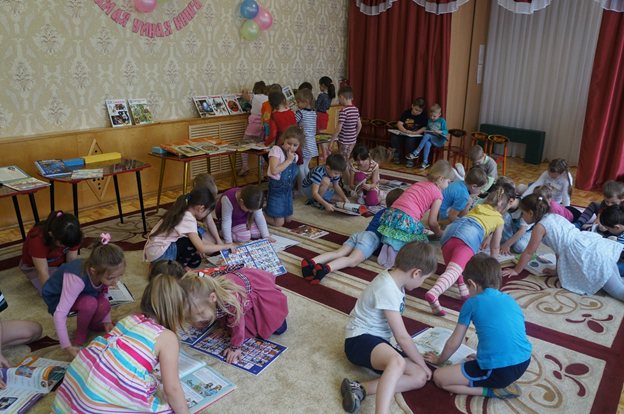
Lesson with children
Iconic didactic materials
One of these multifunctional aids is “Teremok”. It is a fabric house attached to a flat, solid base. It has a large number of pockets sewn into it, in which various pictures are placed. They can depict objects of the surrounding world, fairy-tale characters from the fairy tale of the same name, images of letters or syllables.
Complex of articulation gymnastics for children 4-5 years old in the middle group
There are various ways to use this manual in kindergarten.
Here's one of them. Children are shown pictures taken from a pocket attached to the tower. They ask what fairy tale this hero, who is depicted on the card, came from. The child must remember the name of the fairy tale and try to retell its content.
Important! If the child needs the help of a speech therapist, then it is provided. During the story, the teacher asks the child simple leading questions.
You can also use this manual in a preschool educational institution as follows:
- The teacher takes out cards showing the inhabitants of the tower, but does not show them. He depicts the sounds these animals make. The child must repeat them and name the hero of the fairy tale who is depicted on the card.
- The manual can be used to study prepositions that show the relative position of cards. The teacher places cards with pictures of animals in various pockets and asks questions about who is located where. The child must answer using the prepositions “above,” “under,” or “between.”
- Then the child is asked to formulate questions using the mentioned prepositions and ask them to the teacher.
Another task is the following:
- The child is given cards with images of fairy tale characters and asked to place them in various pockets.
- After this, the kid must say which animal lives on which floor and who is to the left, right, above or below him.

